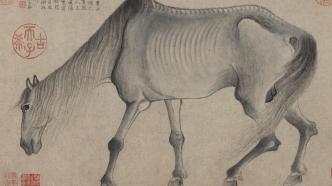
Gong Kai, a survivor painter from the late Song Dynasty and early Yuan Dynasty, has few extant paintings but all of them are very distinctive. The "Horse Bone Picture" now in the collection of Japan depicts a skinny old horse, and was later inscribed by Yuan Dynasty figures Gong Ying, Chen Shen, Yu Zhuo, Yang Weizhen and Ni Zan. This article combines the scroll and Gong Kai's life to discuss the meaning of the painting and the possible recipients of the painting, pointing out that the image of the thin horse is closely related to the emotions of Gong Kai's survivors. People in the Yuan Dynasty wrote poems using horses to describe people, expressing similar feelings of compassion to Gong Kai.
Zhao Mengfu once recorded in his "Landscape Paintings Inscribed on Gong Shengyu": "Back then I also painted Yunshan Mountains, and the green mountains of Yunbai Mountain were just a few feet away. Today I still laugh to myself when I look at the mountains, and I will lose to Chu Gongxian for a long time." This shows his admiration for him.
Chinese horse painting flourished in the Tang Dynasty and the Yuan Dynasty, two dynasties that expanded their territory. Han Qian and Cao Ba in the Tang Dynasty, and Zhao Mengfu and Ren Renfa in the Yuan Dynasty were all famous horse painters with extremely high achievements. If we count further, Gong Kai (1222-1307) of the late Song Dynasty and early Yuan Dynasty is also an important one. His courtesy name was Shengyu, his first name was Shengyu, and his nickname was Cuiyan. He was a native of Shanyang (now Huai'an, Jiangsu Province). Gong Kai served as a public official in the Southern Song Dynasty. Tao Zongyi said that he "set up supervisors and served as officials in the Huaihe system of the Song Dynasty. He was not an official in the court. He was knowledgeable and knowledgeable, and his integrity was different from the common people. As an ancient official, he got the writing style of the Han and Wei Dynasties." After the Yuan Dynasty, he traveled to Hangzhou, Pingjiang and other places as an old man, expressing his feelings in paintings. Those he interacted with, such as Fang Hui, Xian Yushu, Dai Biaoyuan, Qiu Yuan, Mou Yinglong, Hu Changru, etc., were all famous Confucian scholars in Jiangnan at that time, and Liu Guan, Huang Zhu and others looked up to him as juniors. Liu Guan said: "I first saw Mr. Yu in Qiantang Hudong. He is more than seventy years old. He has a sparse beard, beautiful eyebrows, and a slim body, just like the immortal swordsman in ancient paintings, who always recites poems for those who do good things." Huang Muzhe said, " The upright, majestic and abrupt things in his mind can always be seen in the brush and ink." He praised Gong Kai's paintings for conveying a high-spirited and solitary personality. Volume 5 of Xia Wenyan's "Pictures and Treasures" says that Gong Kai's "official calligraphy is extremely ancient...and his paintings such as Zhong Kui, the ink ghost, are strange and bizarre" , which also illustrates the uniqueness of his artistic personality.
As a scribe and former official of the dynasty, Gong Kai's paintings were not careless. He had superb realistic modeling skills and was especially praised for his horse paintings. Gong Kai was also good at painting landscapes, figures, and ghosts. Zhao Mengfu's "Landscape Paintings Inscribed on Gong Shengyu" says, "Back then I also painted Yunshan, and the green mountains of Yunbai were just a few feet away. Today I still laugh at myself when I look at the mountains, and I will lose to Gong Xian of Chu." You can see your admiration for him.
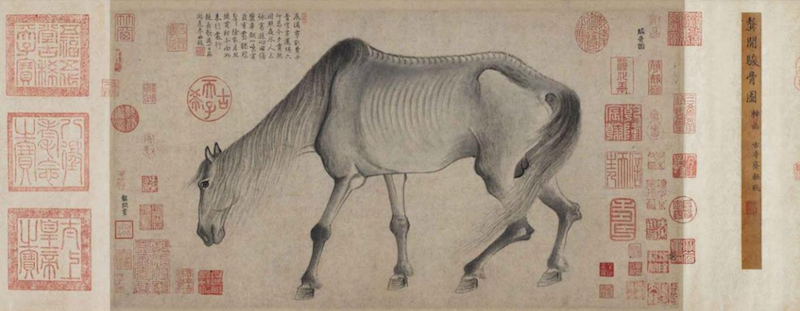
Yuan Gongkai_Horse Bone Picture (detail) Collection of Osaka Municipal Museum of Art
There are not many extant works by Gong Kai, and the "Horse Bone Picture" (Figure 1) currently in the collection of the Osaka Municipal Museum of Art in Japan is a very important one. Ink pen on paper, 29.9cm in length and 56.9cm in width, with eleven lines of official script. After the volume, there are numerous postscripts written by people of the Yuan and Ming Dynasties. It was once collected by Xiang Yuanbian and Li Rihua of the Ming Dynasty, Gao Shiqi, An Qi, Qianlong Neifu, Zeng Xiejun, Lu Shusheng and Wanyan Jingxian of the Qing Dynasty. Recorded in "Painting Appreciation" by Tang Jie of the Yuan Dynasty, "Notes of Liu Yan Zhai" by Li Rihua of the Ming Dynasty, "Notes on Calligraphy and Painting Inscriptions" by Yu Fengqing, "Spectacular Life" by Gu Fu of the Qing Dynasty, "Da Guan Lu" by Wu Sheng, "Continuation of Shiqu Baoji", and Ruan Yuan "Essays of Shiqu", "Record of Famous Chinese Paintings Seen Overseas" by the contemporary Zhu Shengzhai, etc., can be regarded as one of the masterpieces of horse paintings in the past. After the British and French forces plundered the Old Summer Palace in 1860, the painting was leaked and passed into the hands of the Japanese collector Fusajiro Abe. After Abe's death, his son donated more than 160 ancient Chinese paintings and calligraphy, including this volume, to the Osaka Municipal Museum of Art in 1943.
1. A thousand-mile horse that must be thin
Gong Kai's painting of horses was quite famous in the Yuan Dynasty. There are many related records and many poems by Yuan people. Those who can be seen today include Weng Juan, Fang Hui, Yu Delin, Gong Ying, Ma Zhen, Wu Lai, Guo Wei, Yang Weizhen, Wang Feng and others wrote poems on paintings. Fang Hui was a Jinshi in the Southern Song Dynasty and a famous poet in the early Yuan Dynasty. Gong Kai once painted "Jade Leopard Horse" for Fang Hui, and both sides had poems about it. Fang Hui wrote a long poem titled "Picture of the Jade Leopard of Marquis Gong": "...the cursive and official characters are wonderful, and the ancient poems and verses are heroic. Although he has a hobby of painting horses, he is no better than an ordinary painter in the world. He has a beard three feet tall and no one knows him in Chang'an City. Waiting for a piece of paper to write "Hua Liu", or you may not be able to ask for it in your life. I didn't even ask for it, but suddenly I got it, and a jade flower appeared on my sleeve. Opening the book is like hearing the roar of the wind, and stepping on the blue sky to hear the thunderbolt..." He praised Gong Kai for his excellent calligraphy and poetry. I am fond of painting horses, but it is not easy to find. Gong Kai's poem "I wrote a jade leopard horse for Mr. Xu Gu. The gentleman was rewarded with poems, and he expressed his gratitude with this poem." The poem in return read: "... For whom it is easy to come to China. The road to the snowy Tianshan Mountains is long. 'The head is the king, wishing to gain wisdom. The eyes are the form, wishing to gain clarity. The spine is the general, wishing to be strong, and the belly is the city wall, wishing to be stretched. 'Jue Lian, this horse has all the legs, and its fifteen ribs include kidneys and intestines..." , It shows that this "Jade Leopard Horse" is a thousand-mile horse that came to the Central Plains from the Western Regions. It has a square head, clear eyes, strong spine, and open belly. It meets the standards of a good horse mentioned in the "Xiangma Sutra" and has fifteen ribs.
It is also a painting of horses. What Gong Kai painted was not the powerful and famous horses from the Western Regions that were presented to the royal family of the Tang Dynasty in the works of Han Qian and Cao Ba, nor the horses for the kings and nobles to ride and play in the works of Li Gonglin and Zhao Mengfu. It is a horse that gallops on the battlefield as Du Fu's poem says, "The Huma is named Dawan, and its sharp edges are thin and thin." Due to the different identities of the painter and the target audience, Gong Kai's paintings of horses present a completely different aesthetic pursuit from those of his predecessors. "Horse Bones" from Gong Kai's collection in Osaka, Japan, uses a sketch-like ink painting method to depict a skinny old horse with short but strong legs, firm eyes, fifteen clearly visible ribs, and its mane and tail fluttering in the strong wind. . On the back of the paper, there is an official inscription by the author : "As soon as the clouds and mist descended from the sky, the sky cleared up the twelve leisure days before. Who can pity the bones of the horse today? The shadows on the beach at sunset are like mountains. "The Sutra" says that the ribs of horses are thin and numerous, and the ribs of ordinary horses are only If there are only ten ribs, then there will be a horse's feet. But a thousand-mile horse, as many as ten have five ribs. If you draw bones in the flesh, can you make the fifteen ribs appear on the outside? If they appear on the outside, they must be thin. Because of this appearance, To show the difference of thousands of miles, it is not taboo to be inferior. Huaiyin Gong Kai Shui Mu Gu Qing Shu."
The first two lines of the seven-character poem say that this horse fell from the sky and made military exploits. Its extraordinary courage eclipsed the royal horses of the previous dynasty. The last two lines say that it has been idle for many years, but it still stands as tall as a mountain even though it is thin, which is quite tragic and heroic of a hero in his twilight years. Gong Kai's painting and the poem Qijue are both recorded in Yuan Dynasty Tang Gao's "Ancient and Modern Paintings" and Wu Shidao's "Wu Libu Poems". On the one hand, it shows that both of them have seen this painting, and on the other hand, it also reflects their understanding of Gong Kai. Start appreciating this poem. As for why you want to draw a thin horse? Gong Kai's explanation is that because a thousand-mile horse has more ribs than an ordinary horse, in order to show fifteen ribs in the painting, it has to be thin.
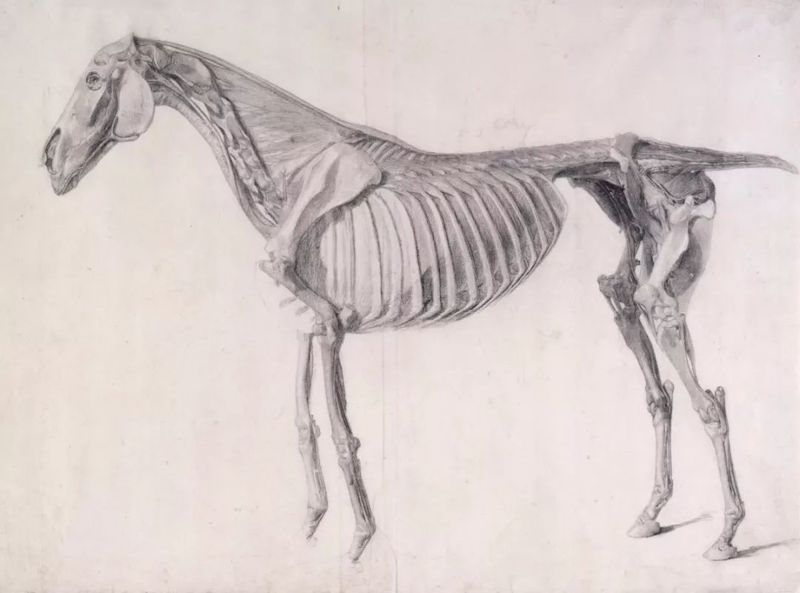
George Stubbs "The Anatomy of the Horse" (15 ribs)
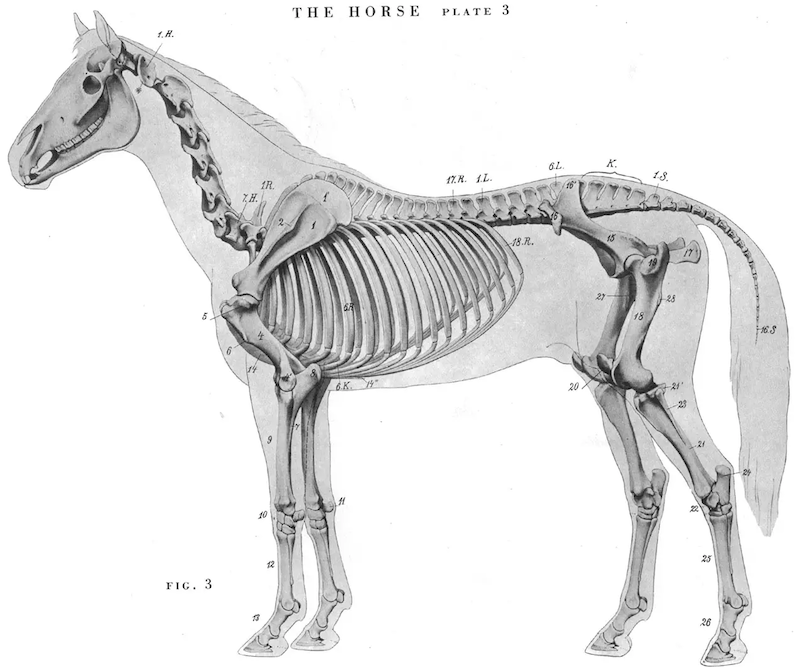
Horse skeleton diagram (18 ribs)
Chinese equestrianism appeared in the pre-Qin period. People discovered that the body structure of horses is closely related to their sports functions. Mastering their laws will help to select good horses for different purposes. Documents such as "Xiangma Jing" were circulated in the Han and Tang dynasties. Regarding the ribs of horses, the ancients believed that those with many, thin and dense ribs were horses. The "Xiangma Jing" recorded in Volume 6 of "Qi Min Yaoshu" in the Northern Wei Dynasty says: "Count the ribs from behind, and the tenth one is good. For any horse, if it is eleven, it will be two hundred miles; if it is twelve, it will be a thousand miles; if it is more than ten, it will be a thousand miles. The third one, Pegasus, has one ear. One goes: Thirteen ribs are five hundred miles away, fifteen ribs are thousands of miles away." In fact, most breeds of horses in the world have 8 pairs of true ribs and 10 pairs of false ribs. The ribs that are directly connected to the sternum (front) are called true ribs, and the ribs that are connected to the previous costal cartilage by costal cartilage (posterior) are called false ribs. The shorter ribs located in the front are hidden under the shoulder blades and muscles of the forelimbs and are difficult to see, so the ancients believed that horses with fifteen ribs were rare. The thin horse in "Two Horses" by Ren Renfa of the Yuan Dynasty (collected by the Palace Museum) has 16 ribs drawn on it. In the book "The Anatomy of the Horse" by the 18th-century British painter George Stubbs, 15 ribs were drawn (see table above). These paintings reflect the understanding of the horse's skeletal structure at the time.

Gong Kai's "Horse Bone Picture" (15 ribs)
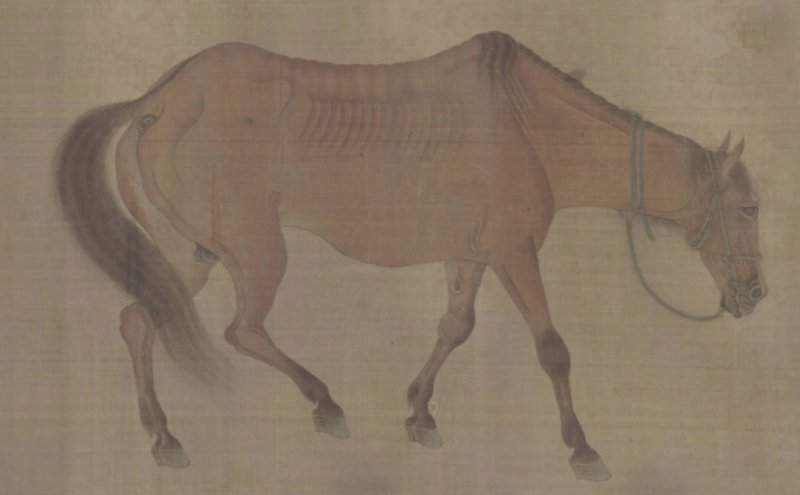
The thin horse (16 ribs) in Ren Renfa's "Two Horses"
Regarding Gong Kai's paintings of horses, Yu Delin of the late Song Dynasty and early Yuan Dynasty wrote a poem titled "Inscribed on the Picture of Gong Shengyu's Slender Horse Collected by Guo Yuande":
I heard that the divine horse has fifteen ribs, and its majestic posture is like a dragon or a tiger.
Four hooves with iron tail and tip of wind, despise Kunlun Boxuan Garden.
When did the calendar block slip by mistake, and the wild forest and hazy wilderness were abandoned?
Thinking of the past, there were twelve leisure days in the past, and the horses and horses were in the meantime.
This horse was the most elegant at that time, and it traveled thousands of miles to Hanguan.
Now that I have fallen into the human world, who can take care of me and think about my ultimate benefit?
Beard Gong's predecessor, Li Boshi, was attentive and compassionate to Quan Qi.
People sigh when they see his skinny bones. He is still thousands of times over.
The stars in the sky have been empty for a long time, and it is rare to see this picture or this horse.
The master loves pictures as much as he loves horses, and he cleans up the paintings as imitations.
I know that when I want to paint my beard, the sky and the earth are dark and windy and sad.
If the grains and millets are separated from each other like this, who knows the true meaning of the grains and grains?
Next year the spring grass will be flat in the wild, and the eight horses in the Yaochi will still be contending.
At this time, the beard and Gong pen are even more beautiful, sweeping the clouds and dragons eight feet away.
Among them, sentences such as "I heard that the ribs of the divine horse are five out of ten" and "Thinking about the past and the past dynasty for twelve times" are very similar to the contents of the "Horse Bone Picture" collected by Osaka and Gong Kai's self-titled "Slender Horse Picture" It may be this "Horse Bone Picture". The reason why we say this is that, in addition to the similarity in the title, the "Horse Bone Picture" collected in Osaka is called "thin horse" instead of "horse bone" in the poems written by Yang Weizhen and Ni Zan at the end. Yuan Tang's "Picture Book" ", Wu Shidao's "Wu Libu Poems", Xu Youzhen's inscriptions and postscripts in the Ming Dynasty, and Li Rihua's "Liu Yan Zhai Notes" all call this painting "Slender Horse Picture", and this name has lasted for three hundred years. Later, the Ming Dynasty Xiang Yuanbian's inscriptions and postscripts, Yu Fengqing's "Calligraphy and Painting Inscriptions and Postscripts" and the early Qing Dynasty Gao Shiqi's inscriptions and postscripts were called "Lei Ma Tu". During the Kangxi period, Gu Fu's "Life Magnificence" and Wu Sheng's "Grand View Records" called it "Jungu". picture". After the painting was brought into the palace, Emperor Qianlong inscribed it with an imperial pen as "Picture of Horse Bones" and it has been named to this day.
2. Lu Xiufu’s circle of friends
If Gong Shengyu's "Slender Horse Picture" in Guo Yuande's collection is Gong Kai's "Horse Bone Picture" in Osaka, then what kind of story is this?
Guo Jingxing, courtesy name Yuande, nickname Yishan, the name of Zhai means Zhai, was born in Zhenjiang, and was a student of Taizhou in the fifth year of Xianchun in the Southern Song Dynasty (1269). After entering the Yuan Dynasty, he successively served as a Confucian professor in Changxingzhou on Huzhou Road and a judge in Huangyanzhou on Taizhou Road. He died at the age of 70 Nine. The eldest son Guo Jing (1280-1335), whose courtesy name was Tianxi, served as the head of the Poyang Academy in Raozhou and the governor of Jiangsu and Zhejiang provinces. His calligraphy and painting were taught by Zhao Mengfu and Gao Fangshan.
Yu Delin (1232-1293), courtesy name Zongda, was originally from Yongjia and lived in Zhenjiang. He was a Jinshi in the ninth year of Xianchun in the Southern Song Dynasty (1273). After entering the Yuan Dynasty, he did not serve as an official. Because of his strong and stubborn nature, he named his house Peiwei. His son Yu Xilu, also known as Yongzhong, was the compiler of Zhishun Zhenjiang Chronicles. He served successively as professor of Confucianism at Qingyuan Road, Cheng of Gui'an County, Yin of Jiangshan and Yongkang counties, and in the 16th year of Zhengzheng (1356), he became a magistrate of Songjiang Prefecture. Yu Xilu wrote the "Preface to the Collected Works of Guo Tianxi" in 1365 and still exists in the world (in "Guo's Poems and Han Volume", collected by the Palace Museum, Figure 2). The preface says, "My father Wei Zhaiweng and your father Mr. Yishan are sworn friends. Keeping the money flowing closely is good for the whole family." It can be seen that the Yu and Guo families live in Zhenjiang together, and the relationship between father and son is close.
As mentioned earlier, Gong Kai traveled between Hangzhou and Suzhou after entering the Yuan Dynasty. What is his connection with Guo Jingxing?
At the end of the Yuan Dynasty, Tao Zongyi copied and compiled a volume of "Cao Mang Private Ride", which were all essays and poems about loyalty, filial piety and justice during the Song and Yuan Dynasties. Among them, three articles by Gong Kai have been preserved: "The Biography of Prime Minister Wen of the Song Dynasty", "The Biography of Lu Junshi of the Song Dynasty" and "Preface to the Collection of Lu Junshi's Elegiac Poems", all of which are articles about the fall of the Southern Song Dynasty. Prime Minister Wen refers to Prime Minister Wen Tianxiang on the right, and Jun Lu actually refers to Prime Minister Lu Xiufu on the left. Lu Xiufu (1236-1279), courtesy name Junshi, was born in Yancheng. He moved to Zhenjiang when he was three years old. He was a Jinshi in the first year of Jingding in the Southern Song Dynasty (1260). He served in the shogunate of Li Tingzhi, a famous general in the Southern Song Dynasty, for more than ten years, and became Prime Minister Zuo. In 1279, he was in Guangdong Yashan carried his infant son across the sea and died for his country at the age of 44. Gong Kai's "Preface to the Collection of Lu Junshi's Elegiac Poems" appendix contains a group of elegy poems by various writers, including Fang Hui, Zheng Chou, Long Renfu, Tang Binglong, Sheng Biao, Yin Yingxu, Yu Delin, Yuwen Shujian, Guo Jingxing, Qiu Yuan, and Hou Kezhong , Fang Feng, Gong Kai and other thirteen people. In order to save space, Yu Delin’s poems are not recorded, but let’s look at Guo Jingxing’s poems:
The black wind blows the waves, and the dragon's beard is filled with breath.
As long as the ministers know all the important things, the country will be rejuvenated.
Who can take care of the children in front of me? I will have enough fame behind me.
I still recall the autumn rainy night in the south of the city, where we had a reading lamp under the same window.
The poem expresses admiration and admiration for Lu Xiufu's heroic sacrifice for his country. The last couplet "I still remember the autumn rainy night in the south of the city, and the reading lamp was shared by the same window" recalls the two of them studying together in the south of Zhenjiang when they were young. Guo Jingxing and Lu Xiufu have maintained contact for a long time. Lu Xiufu's only handed down calligraphy copy of "Qunyu Tie" (collected by the National Palace Museum in Taipei) is a letter written to Guo Jingxing's merchant to borrow Mi Fu's calligraphy.
Gong Kai's "Preface to the Collection of Lu Junshi's Elegies" explains the origin of the collection of elegy poems:
Execution is a matter of a husband's ability; mourning a death is a matter of the utmost affection of a friend. Because he is capable of doing things, he embodies deep emotions, which is the principle of similar things. The servant returned from the south of the spring to the west of Zhejiang. When he heard about the death of the Duke, he was filled with grief. I will pay tribute to the poem but dare not take it lightly, fearing that the rumors will be untrue. For a long time, I heard that Yin Yingxu, a native of the country, said: I got the details in Zhai to recruit the national show, and Zhai got the Xin Shilang to Xin. The minister is from Ouchi, Public Security Bureau, and has an official position in the sea. He has witnessed the incident and is undoubtedly trustworthy. Then grow into a sentence and preface it. Furthermore, since I only care about public affairs in the hearts of the people and in the world, future generations will want to keep their own private interests, so I transcribed it and left it to the authors. Fuwei's authors had known each other for a long time, and some were well-known but not familiar with it, or were familiar with it but were not familiar with it. All of them were based on the laws of nature and the Yi people dealt with it. Fortunately, the words of benefit were published and passed on at different times, which is also the case. The poems are written in no particular order and will be published as they arrive. ...On the twenty-eighth day of March in Renchen, the Huaiyin Palace begins.
During the Southern Song Dynasty, Gong Kai served as an aide to the famous generals Zhao Kui and Li Tingzhi. Li Tingzhi once served as the magistrate of Yangzhou and the envoy of the Lianghuai system. Gong Kai "seldom lived with Xiufu in the Guangling shogunate", that is, he and Lu Xiufu worked under Li Tingzhi at the same time, and had the experience of working together when the country was in crisis. In the dying days of the Southern Song Dynasty, Gong Kai "returned from Quannan to the west of Zhejiang" and must have participated in the struggle against the Yuan army. Later, when he heard the news about the Yashan naval battle and Lu Xiufu's generous death, Gong Kai was "overwhelmed with grief." The signature "Renchen" dates from the 29th year of the Yuan Dynasty (1292), thirteen years after the fall of the Southern Song Dynasty. The 71-year-old Gong Kai did something that was close to his heart - writing the "Preface to the Collection of Lu Junshi's Elegies" He also extensively collected elegy poems from various schools for publication.
During the Chenghua period of the Ming Dynasty, Ding Yuanji, a native of Zhenjiang, compiled a volume of "Lu Youcheng Dancing in the Sea" (Note: Lu Xiufu was actually Zuocheng). In addition to Gong Kai's three articles contained in "Cao Mang Private Vehicle", there is also Yu Xilu's "Inscribed Slips of Privy Master Lu from the Guozhou Judge's Office":
Xilu read the elegy for Lu Gong Xiufu, the Privy Councilor of the Song Dynasty, written by his late son (referring to his father Yu Delin). He has a majestic and resolute appearance, and is still vigorous and lively. If you want to be like his voice, you can't get it. Mr. Yishan Guo and his father-in-law (referring to Lu Xiufu) were roommates. They had collected all the books and slips that they had sent back and forth, and I was able to pay my respects and look at them. The former Xiu Dianxing is very impressive in his eyes, his calligraphy and painting are vigorous, and he is in a class of his own. He cannot be compared to those who are charming and charming. After sighing, I respect the end of the paper.
It can be seen from the above historical materials that Guo Jingxing, Yu Delin and Lu Xiufu were all outstanding literati in Zhenjiang in the late Song Dynasty and had known each other since they were young; Gong Kai and Lu Xiufu were colleagues under Li Tingzhi, a famous anti-gold general. Several of them had deep sympathy for the demise of the Southern Song Dynasty and the death of Lu Xiufu. Therefore, it was a natural move for Gong Kai to collect elegy poems from Guo Jingxing and Yu Delin, or to present "Slender Horse Picture" to Guo Jingxing. The thousand-mile horse on the beach at sunset symbolizes that the achievements and glory are in the past, but the present is lonely, but the character still remains. This is not only a reflection of the emotions of Gong Kai's survivors, but also a reflection of his self-pity in his later years.
We know that in a painter's artistic career, there are often multiple works with the same theme and similar composition. The "Slender Horse Picture" presented to Guo Jingxing by Gong Kai has been found in documents but no pictures. There is no way to confirm whether it is the "Horse Bone Picture" collected in Osaka. However, by tracing the interactions between Gong, Guo, Yu and Lu Xiufu, it will help us understand Gong Kai’s feelings and artistic thoughts as a survivor, and understand the personality significance contained in the image of the thin horse.
Various historical materials do not mention Gong Kai's experience in learning painting in his early years. His painting creation was concentrated in the second half of his life, that is, after entering the Yuan Dynasty in 1279. As a gift to Guo Jingxing, "Slender Horse Picture" was written by Yu Delin, so the lower limit of the painting time must have been when Gong Kai, Guo Jingxing, and Yu Delin were all still alive. The year of Gong Kai's death, according to the preface to "Hehuang Pu Weng sent Gong Yan Weng a horse painting poem" by Qiantang Taoist Ma Zhen, "Dade Dingwei (1307), Huang Pu Weng sent Gong Yan Weng a horse painting poem", Gong Kai died In 1307 or shortly before. The year of Guo Jingxing's death is unknown. The "Guo Jingxing, Guo Jing and Son Hanmo Scroll" collected in the Palace Museum is his latest handwriting, written in Yanyou Jiwei (1319). The year of Yu Delin's death is clear, in 1293, and he was the earliest among the three. Therefore, Yu Delin's "Inscribed Picture of Gong Shengyu's Slender Horse in Guo Yuande's Collection" was painted in 1293 at the latest. Considering that Gong Kai solicited Lu Xiufu's elegy from Yu, Guo and others in 1292 (according to "Preface to the Collection of Lu Junshi's Elegy"), Gong Kai's gift of "Slender Horse Picture" to Guo Jingxing was probably composed in 1292.
3. Three Hundred Years of Circulation in Wu Clan
At the end of Gong Kai's "Horse Bone Picture Scroll" are Gong Zhao, Chen Shen, Yu Zhuo, Yang Weizhen, Ni Zan of the Yuan Dynasty, Yang Zhu, Xie Jin, Liu Yi, Xu Jue, Xiang Yuanbian of the Ming Dynasty, Gao Shiqi, Emperor Qianlong, and Liang Shizheng of the Qing Dynasty. , Wang Youdun, Shen Deqian and others wrote inscriptions. The inscriptions by the five Yuanxians are more important and deepen the connotation of the scroll. The three inscriptions by Gong Zhang, Chen Shen and Yu Zhuo were framed after the inscriptions by Yang Weizhen and Ni Zan. In fact, these three people lived in an earlier era. Let’s talk in order of time.
Gong Ying (1266-1331), courtesy name Zijing and nickname Gu Yangsheng, was a native of Zhenjiang. At first, he served as an aide to Xu Yan, the official envoy to the Western Zhejiang Province for political integrity. He was appointed as the mountain chief of Hejing and Xuedao academies in Suzhou. In his later years, he was transferred to Ningguo Road as a Confucian professor and moved to Yichun County where he died. He is the author of "Cun Hui Zhai Manuscript". Except for a short period of serving as an official abroad in her later years, Gong Ying lived in Suzhou most of her life. She had a good acquaintance with her predecessor Gong Kai, and was called a "forgotten friend" in historical records. Because Gong Ying's father was an official in the Southern Song Dynasty and died on a hunger strike on the way north after the royal family surrendered in the Southern Song Dynasty. Moreover, he studied in Zhenjiang when he was a teenager and received the care of his fathers such as Yu Delin and Mo Lun. Therefore, when he faced Gong Kai's "Slender Horse Picture" , it is inevitable not to have deep empathy.
There are more than a dozen types of Gong Ying's handwriting handed down from generation to generation. The earliest "Postscript of Fan Zhongyan's "Ode to Boyi"" (the second volume of "Gaoyi Garden World Treasures" engraved in the Qing Dynasty) was written in the fourth year of Dade (1300); the middle postscript of Zhao Mengfu "Pictures of Water Village" (Collected by the National Palace Museum), "Postscript of Huang Tingjian's "Hanshan Zizi Pang Jushi's Poems Volume"" (Collected by the National Palace Museum in Taipei), "Preface to the Collection of Jingchuntang Poems" (Collected by the National Palace Museum) were written during the Yanyou period (1314- 1320); the late "Postscript Yuan Yi's "Miscellaneous Poems on Living in Qiantang"" (collected by Shanghai Museum) and "Postscript Wei Liao Weng's "Wen Xiangtie" (collected by Shanghai Museum) were written during the Taiding period (1324-1328). Gong Ying wrote a poem titled "Pictures of Horse Bones" written by Gong Kai: "What is the use of fifteen ribs in creation? Thousands of Luopa silver saddles. But the tribulus is not fat, the bones are like mountains and the intention is like clouds. Gaoyou Gong Ying sighed." (Picture 3) This horse has given up the treatment of "Lopa Silver Saddle" and reflects the spirit of "bones as strong as a mountain". The style of calligraphy is closer to that of the "Preface to the Jingchun Tang Poetry Collection" in 1320. In addition, there is also a poem written by Gong Ying at the back of the volume of Gong Kai's "Zhongshan Travel Pictures" (collected by the Freer Museum of Art, USA). The characters are long and slender and slightly childish. They should be the earliest of Gong Ying's extant ink paintings.
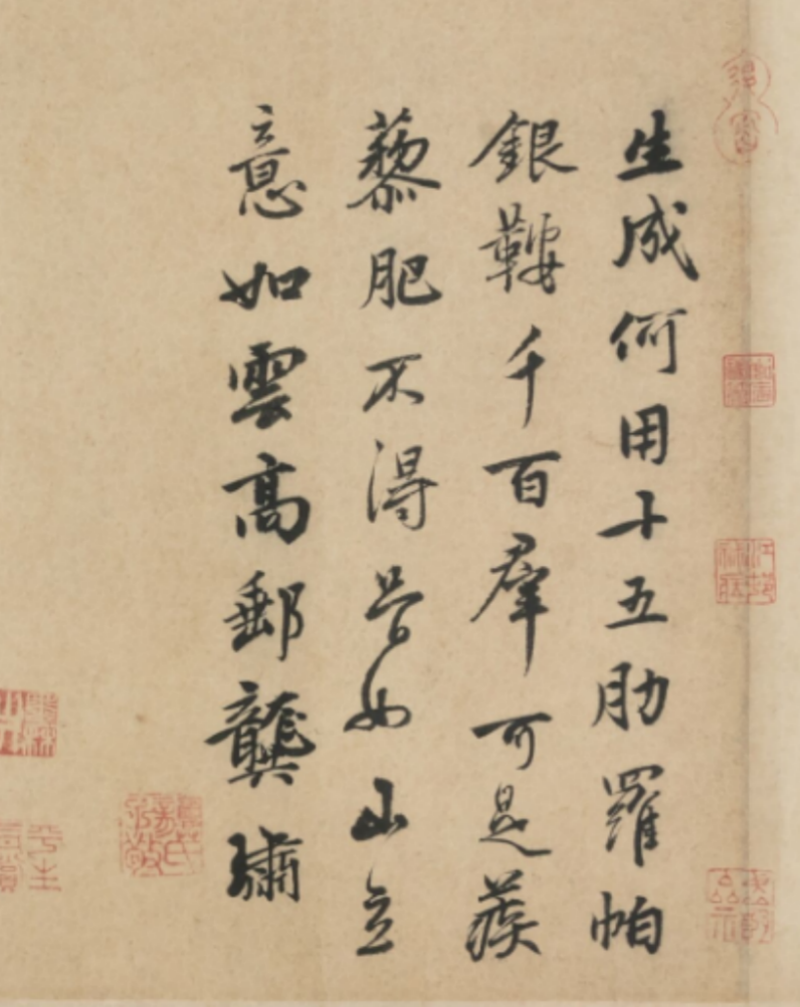
Inscribed on Gong Kai's "Horse Bone Picture"
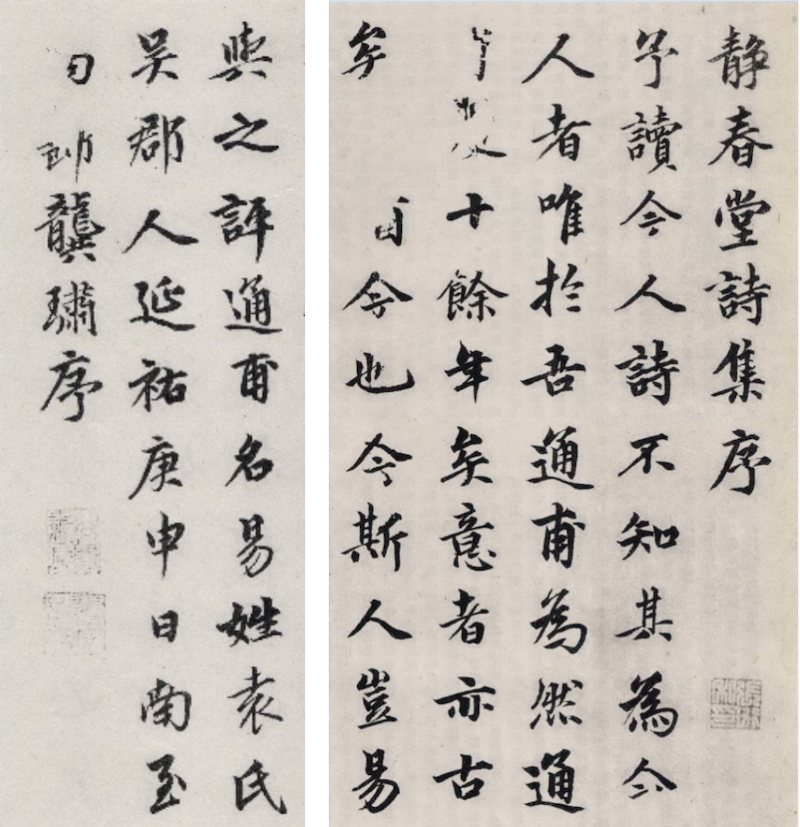
"Preface to Jingchun Tang Poems" 1320
The second poet, Chen Shen (1259-1329), whose courtesy name was Ziwei, whose name was Qingquan, and who lived in Ningjizhai, was from Suzhou. He studied and studied at a young age, and after the fall of the Song Dynasty, he devoted himself to ancient learning, wrote books and taught students, and had many disciples. During the Yuan Dynasty, Kuizhang's cabinet ministers were able to write recommendations and could not hide. Chen Shen was good at writing chapters and poems. Behind Chu Fang's "Qian Kun Sheng Tu" (collected by the British Museum) of the Yuan Dynasty, there were poems written by his chapters. The handwriting is similar to that of Gong Kai's "Jun Gu Tu". Later, there were poems written by his son Chen Zhi. Chen Zhi (1293-1362), courtesy name Shufang, was a man of profound knowledge and good at calligraphy and landscape. His handed down ink ink "Zhi Jin Wen Ruled Slips" (collected by the Cultural Relics Collection of the Chinese University of Hong Kong) mentioned that Ni Zan borrowed books from him, and "Huaicunzhai" "Poetic Notes" (collected by the Palace Museum) was written to Shen You and Ni Zan. Chen Zhi and Yang Weizhen were similar in age, and Chen Shen had already passed away when Yang Weizhen lived in Wumen.
Chen Shen's poem titled "Picture of Horse Bones" written by Gong Kai goes: "I have never seen a horse before, and the cud beans may not be full. It is so weird that its ribs can be counted. If you are so weak, you can't be thousands of miles away. Paint this Painted by gangsters, there is a profound meaning in it. Chu Gong and Meng Zhuang are both metaphors for horses." He said that a horse cannot become a true thousand-mile horse if it does not receive attention and is not well fed. Gong Kai's paintings have a profound meaning. . Chen Shen never left Suzhou throughout his life, and his poem may indicate that the painting has been transferred to the Wu family collectors.
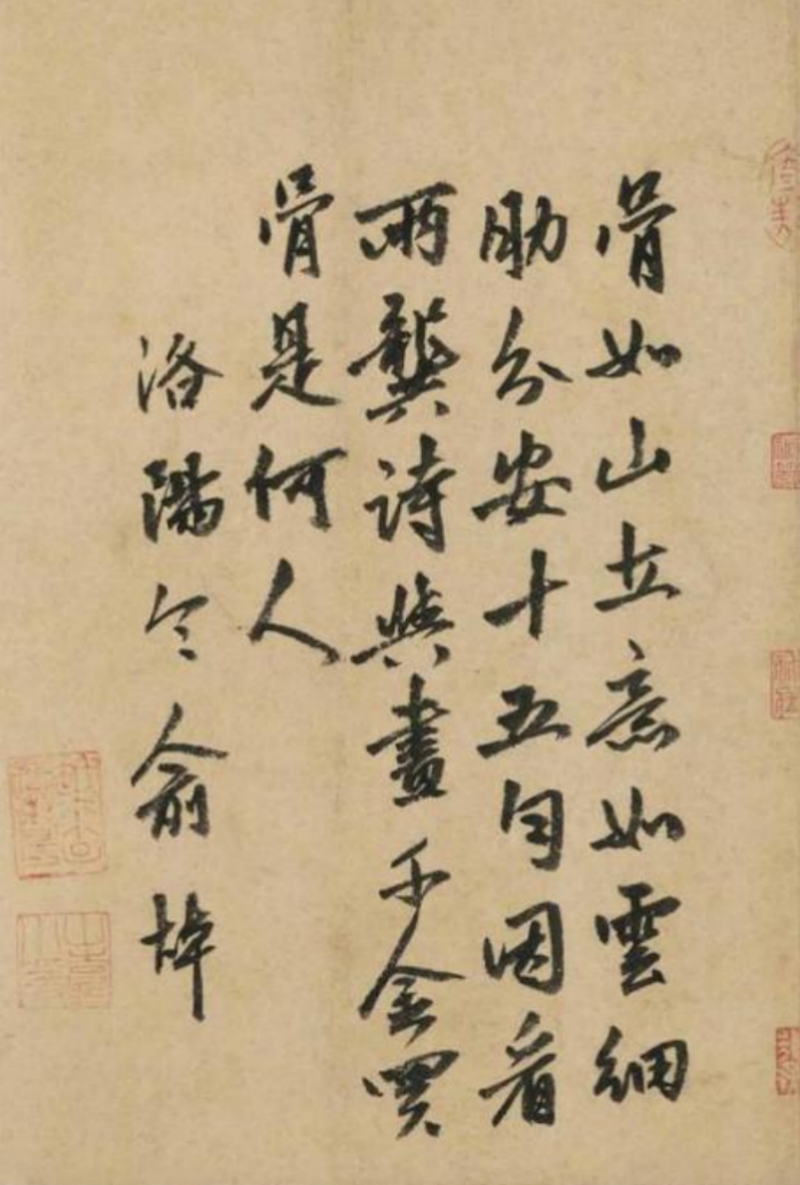
The third poet, Yu Zhuo, whose courtesy name was Yuan (original) Ming and whose nicknames were Wu Weng and Yue Laizi, was from Changle, Fujian. He moved to Taicang, Kunshan with his father Yu Deng since he was a child. He became a Jinshi in the fourth year of Taiding (1327). When he was in Beijing, he discussed the poetry of Fujian and Zhejiang with Yang Weizhen, Huang Qinglao and Zhang Yining, who were Jinshi in the same year. The year of birth and death of Yu Zhuo is unknown, but he may be similar to or slightly older than Yang Weizhen. It can be seen from historical data that in the second year of Tianli (1329), he wrote the postscript to Li Gonglin's "Real Pictures of Monarchs and Their Ministers"; in the ninth year of Zhengzheng (1349), he wrote the preface to Zhu Derun's "Cun Fuzhai Collected Works", saying that Zhu "used literary and ink stories to connect with "It has been handed over to me for more than thirty years"; in the fifteenth year of Zhengzheng (1355), Wang Zhonghe of Wu County wrote "Records of Shuizhu Residence". A few years later, Ni Zan wrote "Pictures of Residence in Shuizhu" and said, "Yu Yin wrote the record, and the waves turned over and the sweat spread. Although he is old and white, he still has the habit of raising children as a young man." It was said that Yu Zhuo was already old at this time. In addition, the Ming Dynasty Li Rihua's Diary of Weishui , there are poems inscribed by Yu Zhuo; the "Album of Five Elders in Suiyang" of the Song Dynasty collected by the Shanghai Museum has poems inscribed by Yu Zhuo; the American private collection of Zhu Xi's "Volume of Poems about the Sickness in the Studio in Autumn" also contains long poems by Yu Zhuo. Since most of the chants are not dated, there is no record that he lived until the early Ming Dynasty.
Yu Zhuo's poem titled "Pictures of Horse Bones" quotes the last line of Gong Ying's poem as the first line: "The bones are like mountains, the intention is like clouds, and the fine ribs are evenly spaced. Looking at Gong's poems and paintings, who can buy bones for a thousand gold? Luoyang ordered Yu Zhuo." He lamented that such a fine horse could not wait for someone to appreciate it. Yu Zhuo was a Jinshi in the top three, and was awarded the title of Prime Minister of Xianju County. During the Zheng Dynasty, he was appointed as the Yin of Dexing County. The appointment of the "Luoyang Order" here can fill the gaps in historical records. According to Yao Zhenhua's "Yao Family Genealogy" (1934 lithographic version, collected by the Archives of Mianchi County, Henan), Yu Zhuo wrote an article and Yao Yu Shudan wrote "Rebuilding the Shaanxi Wenggong Jingxian Temple Stele". The stele is in Shaanxi, the hometown of Tang Prime Minister Yao Chong. Xia Shi Town (today's Shaanzhou District, Sanmenxia City, Henan Province), the inscription is: "After the winter and October of the second year of Zhengzheng, he served as Shilang and Yin of Luoyang County, Henan Prefecture, and took charge of the troops in the county. "Sha Yu Zhuo Ji", it can be seen that Yu Zhuo was appointed as the Yin of Luoyang County in the second year of Zhizheng (1343), and he wrote the poem for Gong Kai's "Jun Gu Tu" around this time.
The fourth person who wrote the poem was Yang Weizhen (1297-1370), also known as Lianfu, also known as Meihua Taoist, Tieyashanren, Tiedi Taoist, Dongweisou, etc., who was born in Zhuji, Shaoxing. Jinshi in the fourth year of Taiding (1327), a famous writer and calligrapher in the Yuan Dynasty. He once served as an official in eastern Zhejiang, Hangzhou, Jiande and other places, and moved to Songjiang in the 19th year of Zhengzheng (1359), where he died. He wrote an ancient Yuefu poem after "The Horse's Bone Picture":
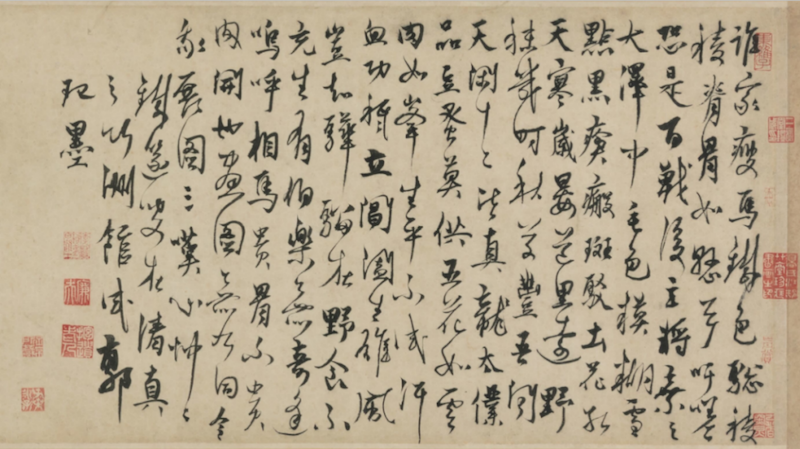
Whose horse is thin and iron-colored, with its spine as sharp as a hanging bow?
I am afraid that after a hundred battles, the general will abandon him in Daze.
The fur is fuzzy, black with snow spots, and the scars are mottled with red soil.
When the weather is cold and the road is far away, wild grass will be abundant in autumn.
I heard that all twelve of Tianxian are real dragons, and the imperial servant cannot offer them any bean fleas.
The five flowers are like clouds and the flesh is like peaks. I will never try my sweat and blood in my life.
When the wind is rising and the wind is rising, how could you know that the wild beasts are not getting enough food?
There is no such thing as luck in life. A horse is more valuable than its flesh.
There is no difference between the drawings and the drawings, which made me sigh and feel very sad when I showed the drawings.
Tiedidisou tried Guo Qimo at the Zhenzhenzhuzhou Pavilion.
Although Yang Weizhen lived later than Gong Kai and did not feel the hatred of the country and family like the people of Song Dynasty, the scrawny Qianlima still shocked the hearts of the literati of the Yuan Dynasty under the rule of ethnic minorities. The sighs of "the master will be abandoned in the great swamp" and "no luck will ever come to him" are connected with Yang Weizhen's bumpy career, conveying a questioning of the value of life.
The date of this poem is not signed, but it can be roughly inferred from the inscription "The Iron Flute Old Man is at the Bamboo Island Pavilion of the Moslem". The Mosque is located in Zhiyang, Ma'anshan, Kunshan (near Jingyang New Village, present-day Huanbei Road). It was built in the Song Dynasty and is a famous Taoist temple in Kunshan. Yang Weizhen mainly visited Kunshan in two periods. One was in the eighth year of Zhizheng (1348) when he visited Kunshan Yushan Thatched Cottage from Suzhou and was received by Gu Ying; the other was when he traveled to Kunshan from Songjiang in the late Zhizheng period and lived at the foot of Yufeng Mountain. At this time, Gu Ying had gone to Jiaxing to avoid disaster. Yu Shan, the abbot of Qingzhen Temple, learned poetry from Yang Weizhen and learned a lot from it. Yang Weizhen left many ink marks on the Qingzhen Temple, such as "Wanjietang Poems" (Collected by the National Palace Museum, Taipei) and "Preface to the Poetry of Xiao Youxian" (Collected by the National Palace Museum) written by Yu Shan in the spring of the 21st year of Zhizheng (1361). Yuan Hua postscripted Zhang Yu's "Album of Poems Written by Himself" (collected by Jilin Provincial Museum), and in the spring of the 23rd year (1363), Yu Shan wrote "Album of Poems Singing and Harmonizing with Immortals" (collected by Shanghai Museum), as well as the undated "Xi" "Poetic Scroll of Flowing Water" (collected by the Shanghai Museum) and "Scroll of Spring Mountains" (collected by the National Palace Museum, Taipei) both indicate in their signatures that they were created in the "Bamboo Island Pavilion of the Moslem Temple". The seals he affixed to Gong Kai's poem "Horse Bone Picture" were commonly used in his later years, so the time when he composed the poem was probably between 1361 and 1363. The collector may be from Kunshan or Suzhou.
In his later years, Yang Weizhen's calligraphy was vigorous and exciting, and his small characters were particularly wonderful. Because the line spacing and word spacing are almost equal, the whole article is coherent, emphasizing the overall sense of the chapter. The inscription is "Testing Guo Qi's ink", and similar expressions appear many times in his ink, such as the "Lotus Boat Crescent Picture Scroll" by Yuanren, the "Youyu Qiu He Tu" by Zhao Mengfu, and the "Bing Flute Picture Scroll" by Qian Xuan. ” as well as “Chen’s Miscellaneous Notes in the Bamboo Forest”, “Wuxia Yuntao Shiping Zhi”, etc., which demonstrate his particularity in the use of ink. Guo Qi was a famous ink maker in the Southern Song Dynasty. "History of Ink" written by Lu You of the Yuan Dynasty said: "Guo Zhonghou is a famous ink maker, Zhonghou is the son of Qi, and Qi is happy. Zhonghou's ink still has ejaculation, and its face is written with double-spine dragon characters, and the curtain is It is said to be 'Made by Guo Zhonghou, a minister of Jimao, Jiading'. There is a piece of ink in the family of King Xuanzi of Kuaiji, with the inscription 'Restored palace system, made by Guo Qi, a minister of Yiwei in Duanping'." Guo Zhonghou and Guo Qi, their father and son, once made ink for the royal family of the Southern Song Dynasty. The ink spread to Yang Weizhen's time and has become a very valuable century-old ink. Both Yu Ji and Zhang Yu of the Yuan Dynasty wrote "Testing Guo Qimo" in their signatures. Yang Weizhen may have been influenced by them.
There is also a poem written by Ni Zan, a painter in the late Yuan Dynasty, at the back of the volume of "Pictures of Horse Bones": "...the old man in Huaiyin is loyal and loyal, and his short brown snow beard belongs to the Song Dynasty. When the country is dead, I recall the Southern Dynasty, and I am full of poetic thoughts in painting. Song Jiang was thirty Xiao Xingmiao, the ghost team of Zhongshan is particularly impressive. A tall horse conveys meaning to a craftsman, and the poem becomes a picture of a thin horse. The sunset is like a mountain shadow on the beach, how can one walk vigorously in the leisurely day? Later generations only know that paintings are precious, but who knows that righteous men are angry Galls of desire!" (Picture 7) The "Thirty-six People in Songjiang River", "Zhongshan Travel Picture", "Tall Horse Picture of Children" and "Skinny Horse Picture" mentioned in the poem are all important works of Gong Kai. Ni Zan praised Gong Kai's loyalty and believed that Gong Kai painted "Slender Horse" to express his resentment against the current situation.
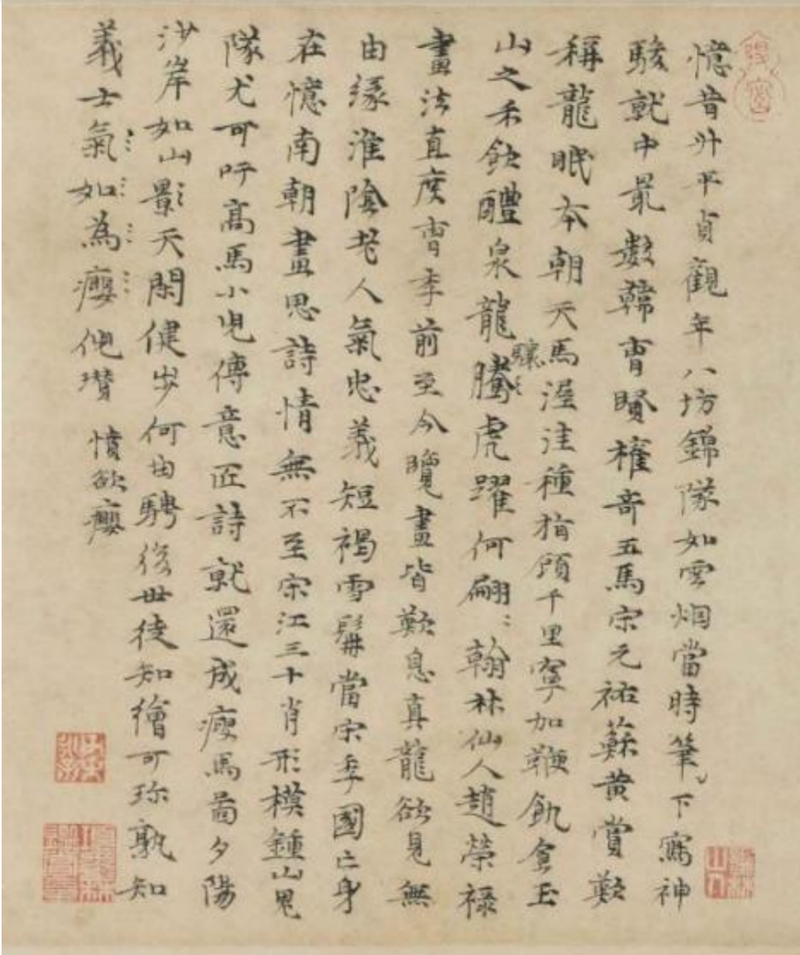
Judging from the living areas of the above five inscriptions, Gong Zhan and Ni Zan have lived in Suzhou for a long time, Chen Shen is from Suzhou, Yu Zhuo is from Taicang, and Yang Weizhen traveled to Wumen and wrote poems in Kunshan. Later, Xie Jin (also known as Xie Jin), Yang Zhu, and Xu Jue (known as Xu Youzhen) in the Ming Dynasty inscriptions were also from Suzhou. It can be seen that Gong Kai's "Horse Bone Picture Scroll" was passed down in the hands of Wumen collectors for nearly three hundred years until the Ming Dynasty. Later it returned to Xiang Yuanbian in Jiaxing. Yuan Xian's poems and chants all revolve around this thousand-mile horse in the sunset, feeling sorry for its fate and paying tribute to the painter Gong Kai. In other words, both Gong Kai and several of the poets used horses as metaphors to express the depression and depression of not being able to extend their cultural talents and life values in troubled times, and together they deepened the theme of the painting.

Yuan Gongkai_Horse Bones Picture 29.9×56.9cm, ink and pen on paper, Osaka Municipal Museum of Art Collection
(This article was selected for the 2023 Seventh Regional Art History Symposium and included in the collection of papers. The author is a member of the Academic Committee of the Chinese Calligraphers Association, a member of the China Art Association, a member of the Xiling Seal Society, a doctor of art, and a cultural and museum research librarian.)